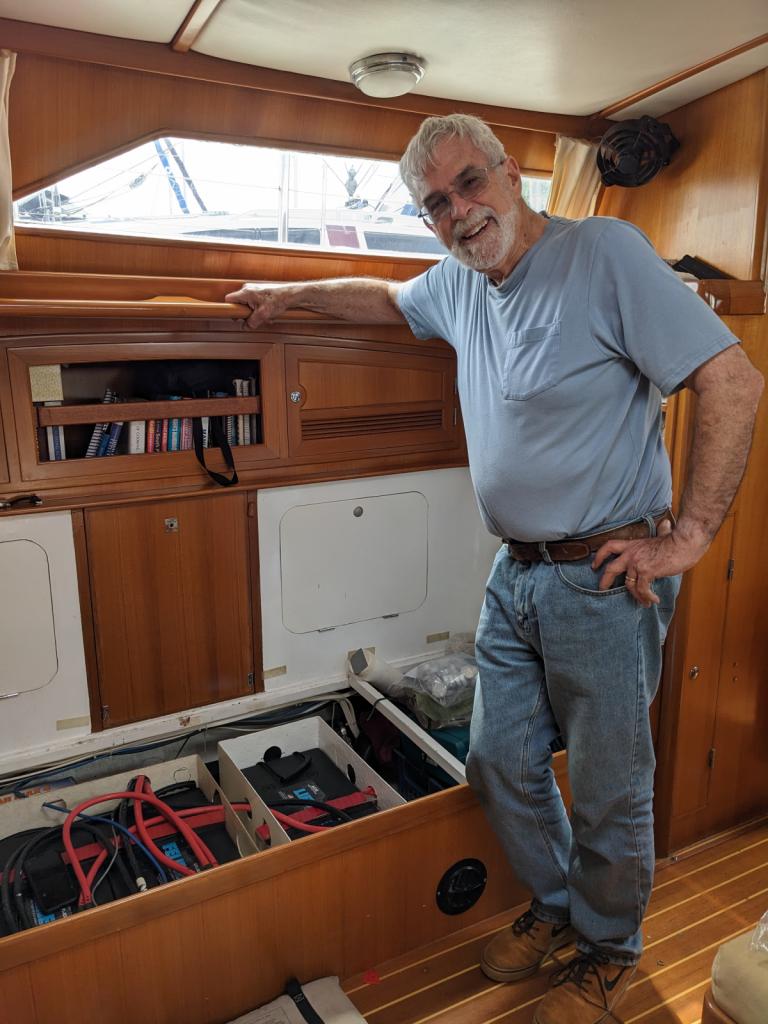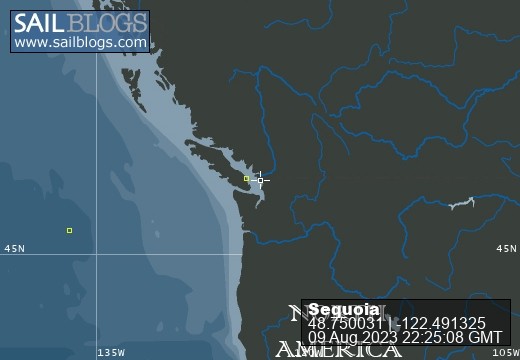
Sequoia Changing Latitudes
30 August 2023 | St. Helens, Oregon
09 August 2023 | Bellingham, Washington
21 July 2023 | Boat: Bellingham; C&B: Scappoose
10 July 2023 | Egmont, Sunshine Coast, B.C., Canada
02 July 2023 | Walsh Cove, Desolation Sound, B.C., Canada
23 June 2023 | Westview/Powell River B.C.
18 June 2023 | Ganges, Saltspring Island, B.C., Canada
22 June 2019 | Scappoose, Oregon
27 May 2019 | Back home in Oregon
09 May 2019 | Villas Alturas Hotel, Costa Rica
02 May 2019 | San Vito, Costa Rica
23 April 2019 | Golfito, Costa Rica
11 April 2019 | Panama City, Panama
04 April 2019 | Shelter Bay Marina, Colon, Panama
22 March 2019 | Jamaica
11 March 2019 | Zar Par Marina, Boca Chica, Dominican Republic
18 February 2019 | Culebra Island, Puerto Rico
31 January 2019 | Simpson Bay Lagoon, Sint Maarten
21 January 2019 | Nelson's Dockyard, English Harbour, Antigua
04 January 2019 | Portsmouth, Dominica
Åland
23 July 2017 | Stämmarsund, Sweden
Barbara/warm and sunny
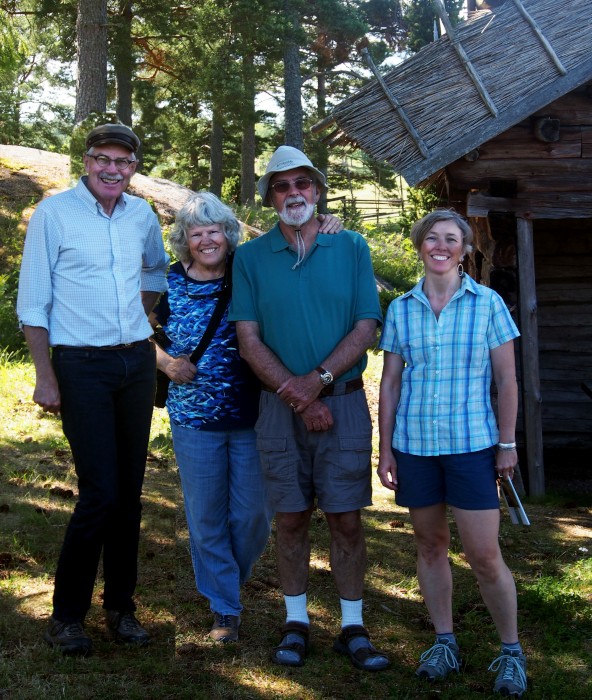
This morning we sailed back from the Åland Islands toward the Stockholm archipelago in Sweden. We had a great time in Åland, accompanied by Mark Downing and Fern Elledge, friends from Portland who came over for this part of our trip.
Five days ago, we left Stockholm, dodging cruise ships, ferries and hot-doggers to wind our way through the intricate channels that weave out from Stockholm for miles before reaching the Baltic Sea. Mark was looking for castles, so we enjoyed the views of Vaxholm Castle midway through our trip.
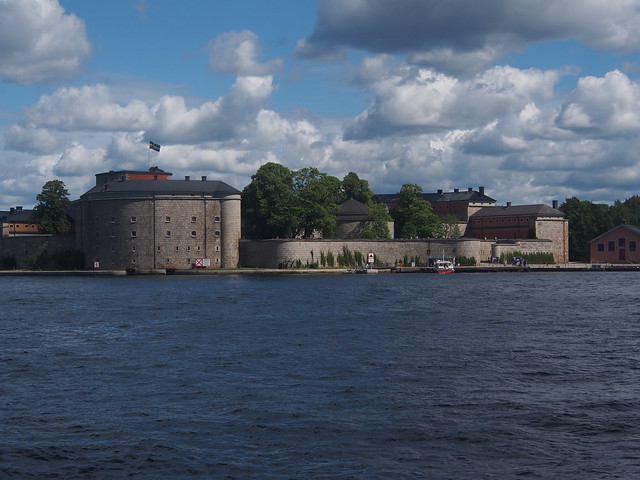
Shortly after that the interesting sight was several granite islands with skeletons of dead trees and a very large colony of big black birds. We wondered what may have killed the trees and what kind of bird was inhabiting them, but we have no answers as yet.
We were headed for an anchorage Craig had picked out of one of the cruising guides for the Stockholm archipelago. Unfortunately about 15 other boats were headed for the same place. We got ourselves satisfactorily anchored, but someone else came in and anchored too close, and Craig wasn't happy with that, so we pulled the anchor up and moved 50 feet to another location. It was a warm sunny afternoon, and we spent a few hours in individual pursuits: reading, napping, painting (Mark) and playing cello (me).
At about 5:00 in the afternoon, Fern noticed that we were getting closer to the rocks and we decided the anchor was dragging. Unfortunately, before we could do anything about it, we were solidly aground on an underwater rock. A Dutch boater yelled, unhelpfully, "There's a rock over there..." (He apparently didn't realize we were already aground).
We looked around for another boater with a dinghy who might be able to help us kedge out a second anchor. We did find a Swedish fellow, interrupting his dinner prep, and he came right over in his dinghy. He and Mark carried our big Fortress anchor out about 200 feet and dropped it into the water. He managed to get Mark back to Sequoia just as his timer went off, signaling his boiling pasta was now ready.
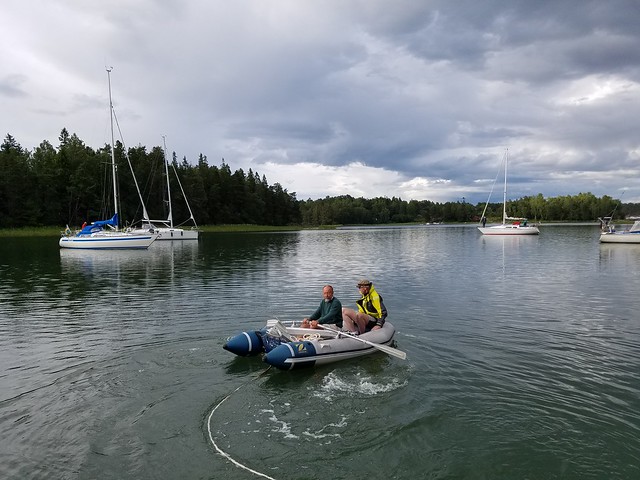
Using the windlass, we pulled on the Fortress anchor's line and managed to get the boat turned 90 degrees, but that was it. We weren't moving any further. And in the Baltic Sea there is no tide, so we can't expect the water to come in and lift us off. We finally concluded we needed some professional help, and another boater provided us with a phone number for the Sea Rescue service. While we were waiting for them to come, Craig decided to pull in our main anchor (the one that had originally dragged). Amazingly, doing that somehow pulled us off the rock. We talked to Sea Rescue again and told them we didn't need their help after all. We motored carefully out of the crowded anchorage and decided to find a dock to tie up for the night.
A mile or so further on, we found the Hogmarsö guest harbor, described in the cruising guide as having all the necessary facilities. It was dusk when we got there, so we just tied up, got our dinner, and went to bed, figuring we'd check in and pay for the moorage in the morning. The dock had the smallest mooring rings we'd ever seen, and you would seriously doubt your safety if the wind blew very hard. No electricity on the docks, although obviously there once had been electricity - you could see the old wires and junction boxes dangling down in the water.
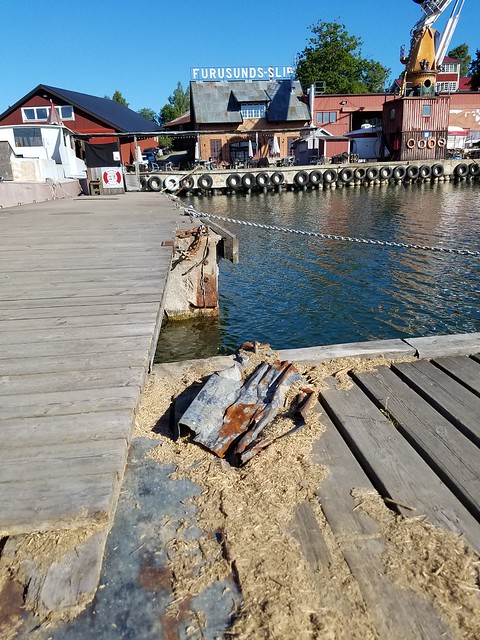
Above: One of the Hogmarsö guest harbor's maintenance/safety issues: vast amounts of sawdust created as the docks rubbed against each other.
Probably the strangest thing about the harbor was the collection of weird boats tied up there. Number one in that collection was a giant metal Chinese-style dragon at the bow of a three-story building mounted on a big barge, and labeled as some sort of Asian restaurant. It was obvious from its state of disrepair that it was not an operating business, but I must say, arriving at the harbor with the dragon looming out of the dusk was somewhat bizarre.

The next morning I found a fellow ashore who explained that this was a boatyard, primarily repairing old working boats, although he himself was a sail rigger who used the space. He said the owner of the shipyard (if we had questions) was a man named Hasse. (Our sailmaker at home is Carol Hasse of Port Townsend sails - wondering if that's a common last name, or perhaps they're related?) The harbor has no guest facilities except for the old docks, and there is no charge for tying up. They were hoping we would patronize their restaurant, little cafe and grocery store. None of those were open yet, and we were anxious to get on our way to Åland.
We had about 8 miles more to go through the islands before we reached the Baltic Sea proper, then about 40 miles across the Gulf of Bothnia to reach Mariehamn, the capital of Åland. (Åland is a semi-autonomous part of Finland, but most of the people in this group of islands speak Swedish.) There was a brisk wind and we had a very nice sail all the way into the Mariehamn harbor.
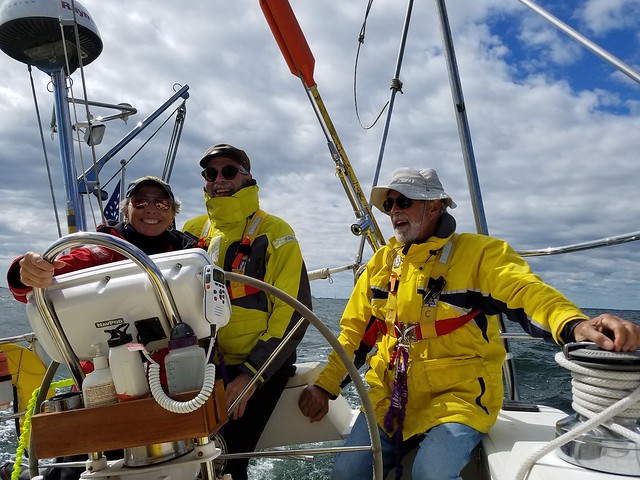
A young man in the guest harbor dinghy came out to greet us, and told us the only spot available was an upwind space at the north end of the harbor. The mooring method here is getting a line strung through a buoy on the way into the space and then slowing down enough to not crash into the dock. Even worse, each buoy in this marina was shared by 2 or 3 boats. In the strong winds, given our inexperience with this mooring method, we elected to find an anchorage instead.
The young man in the dinghy directed us to the nearest good anchorage, and we were able to settle successfully there. The anchorage was just across from the monstrous landing area for ferries and cruise ships. These ferries, which are as big as a cruise ship, use the space between the anchorage and the dock as a turning basin. Several times during the evening and night we heard the rumble of big engines, relatively close by, and we looked out the ports to see the giant ferries spinning half a circle.
The next morning the winds were gone, and we easily moved to the marina. Many boats leave marinas early in the morning, and in the crowded days of the high season, that's the best time to come in. We found a space next to a Finnish-flagged boat. The owner came over to catch our lines, and afterwards told us that he and his family were just in the process of moving back to Finland after three years in Salt Lake City. They were living on their boat while waiting for the shipping container with all their possessions to arrive. While living in the states, they had come back to Finland every summer to go sailing, but otherwise enjoyed their time in the States very much.
As always, we met many interesting people on the docks. A bright red boat was named Red Roo, and turned out to be Australian. The couple had traveled to France, bought the boat there, and were sailing it home over a period of several years. This is their year to be in the Baltic.
The Mariehamn marina is called ÅSS (pronounced "Oss") which which stands for Åland Sailing Club. Their club is very active, with several classes of dinghy racing every day and big parties on weekends. The facilities are very nice (including saunas adjacent to the shower rooms). Quite obviously the income from the summer boating visitors helps fund their operations.
Mariehamn the town is quite different from other Scandinavian cities we have visited. The streets are wide and tree-lined, calling to mind some Midwest American cities. Many of the houses appear to be 100 to 150 years old, with stone foundations. The favored colors seem to be red, yellow or grey.
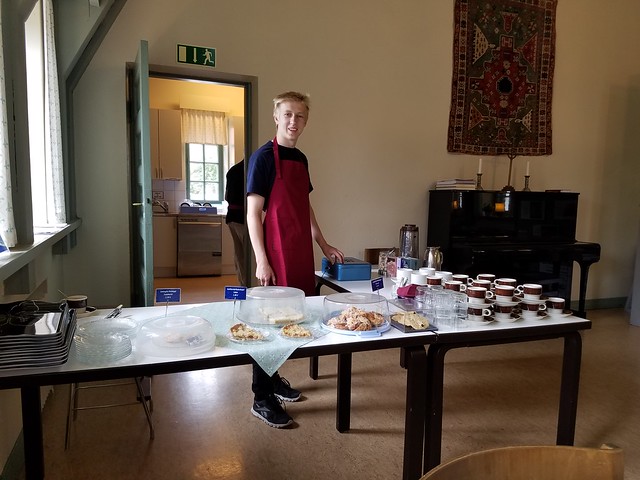
We walked toward the grocery store, getting waylaid by a cafe in a historic church's community hall. The shy but charming young man tending the tables was primarily serving Fika, with excellent coffee and sumptuous pastries, but we were also able to get sandwiches and call it lunch. The hall itself was interesting, heavily protected from winter weather with a radiator under each window, thick walls and old fashioned double-paned windows (no vacuum between the panes, simply two separate windows separated by about 3 inches of air).
We rented a car that afternoon, and headed to the northwest corner of the island, a town called Eckerö. The Lonely Planet advised that a particular restaurant there, overlooking a harbor, was a good bet. It turned out that the harbor was jam-packed with visiting yachts, and they were all in the restaurant. There was an estimated 1½ hour wait for seating. We walked around the interesting marina, which consisted of a boardwalk pinned to the glaciated granite rocks of the shoreline, with an endless row of boats tied to stern buoys, nosed up to the boardwalk. In appearance the inlet was more like a mountain lake, with short-needled pines and huckleberry-type shrubs above the rocks.
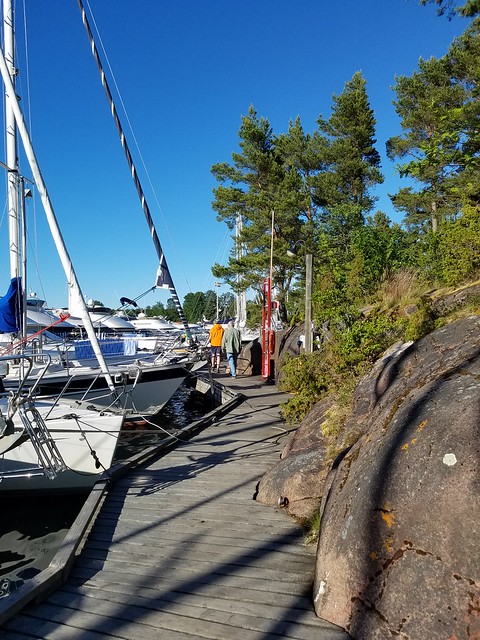
We could see another restaurant in the distance, across the water, so we drove up there and found the "Bistro" of what was called a "Resort and Conference Center", but appeared to actually be an elegant campground. It had the feel of a summer camp, with a white sand beach in front of the Bistro, people swimming with inflatable pool toys and small boats available for patrons' use. We ordered pizza and salads and enjoyed looking out at the beautiful scenery.
The next morning we packed a lunch and set out for Kastelhamn, Åland's only castle. Castles are always fun to visit, and there appear to be many different methods and degrees of restoration. This one was nice, in part because it had lots of signs in English, and in part because it clearly described the different periods of the castle's use and how the structure changed over the centuries. There were guides taking groups around, but none speaking English. We learned about Swedish, Finnish and Russian history, and about witch trials that had taken place there in the early seventeenth century.
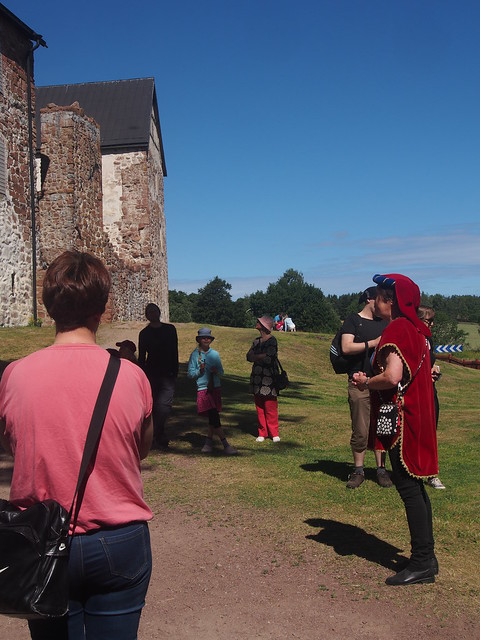
After we had our picnic lunch, we toured Jan Karls-gården, an open air museum of historic buildings from around Åland. (See photo at the top of this page). There were three windmills ("pole mills"), and the brochure explained that historically every farm had a windmill. There was also a "splash mill" set up to operate a grain grinding operation using just the water from a small creek. We saw farm houses for different levels of wealth, stables, a sauna, a boathouse and a foundry. We learned more about the midsommar pole which we have seen in several places. Typically they are as tall as a civic flagpole, and have a sun, a circle of sailboats sailing around the pole, a puppet figure who flaps his arms, cross beams with colorful crowns of fabric and a network of (now-brown) greenery. All these elements are symbolic of prosperity, fertility, favorable winds, and I'm sure other elements I've forgotten already. Apparently the midsommar poles are erected on the eve of the summer solstice and stay in place until just before midsommar the following year.
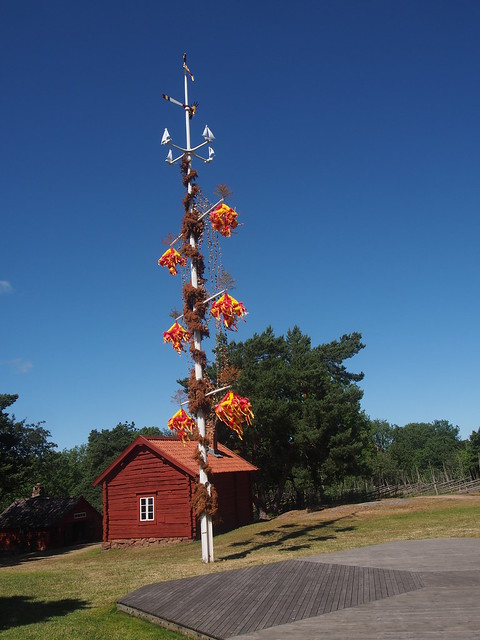
Above: Midsommar pole at Jan Karls-gården
Below: Craft workers in Jan Karls-gården
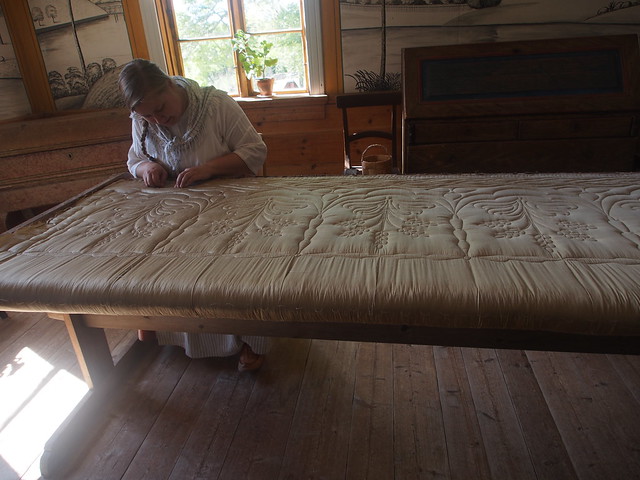
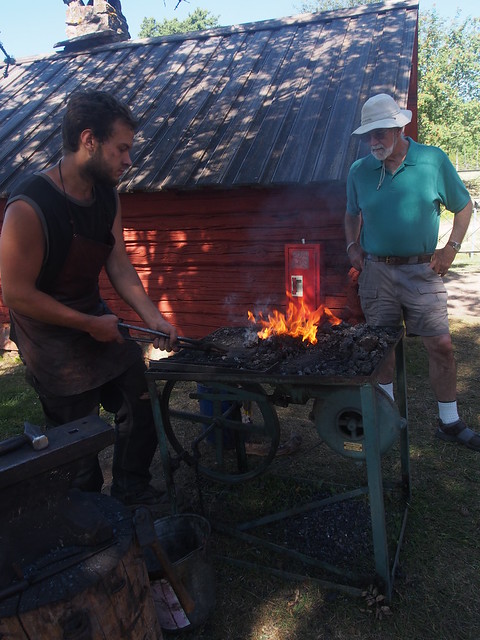
We returned the rental car, did our laundry that night and planned to depart yesterday morning. Before our departure I walked to buy a few more groceries, and just above the marina saw the start of an American car show. The Scandinavians generally, and perhaps the Ålanders in particular seem to love American cars from the fifties. All this summer we have seen here and there gigantic tail-finned Cadillacs and other American luxury car brands (especially convertibles) plying the streets, especially on the weekends. There had seemed to be more than a few here in Åland, including an Edsel parked on the street above the marina. For this show, they had 30 or 40 old American cars lined up. You could see them all, plus buy souvenirs in the booths, for 5 euros. I certainly didn't want to pay for that, but it was interesting looking from afar. Somewhat distressingly, some of the booths were decorated with big Confederate flags. Perhaps they have no idea.

I bypassed the grocery store for the Saturday morning farmers market and picked up a big box of wild blueberries. The young man tending that booth said the berries had been picked the day before in forestland near the Castle we had visited.
We headed for the southernmost anchorage in the Åland archipelago, Rödhamn. We elected to anchor away from the crowded dock, and managed to find a place in a little bay with no other boats. On shore we could see there was a nice sauna and above it a summer house. Toward the end of the day some people arrived in a small boat, tied up to a dock on the other side of the sauna and proceeded to split wood, kindle a fire for the sauna, draw buckets of water out of the bay and set out chairs on the deck. They went up to the summer house for a bit, presumably waiting for the sauna to heat up, and we went below for our own dinner of Mexican/Swedish enchiladas.
This morning we pulled up the anchor at Rödhamn and sailed gently across the Gulf of Bothnia back toward Sweden. It's been a delightful interlude in our trip, and I'm definitely adding Åland to the list of places I'd like to come back to sometime.
Click here for more pictures of our trip from Stockholm to Åland.
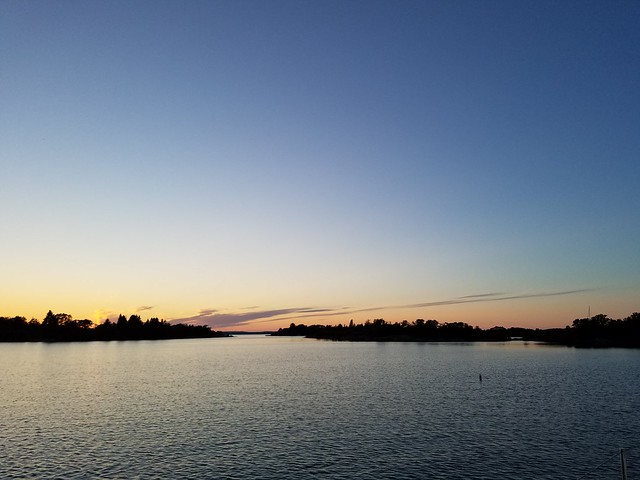
Above: Sunset at Rödhamn
Five days ago, we left Stockholm, dodging cruise ships, ferries and hot-doggers to wind our way through the intricate channels that weave out from Stockholm for miles before reaching the Baltic Sea. Mark was looking for castles, so we enjoyed the views of Vaxholm Castle midway through our trip.

Shortly after that the interesting sight was several granite islands with skeletons of dead trees and a very large colony of big black birds. We wondered what may have killed the trees and what kind of bird was inhabiting them, but we have no answers as yet.
We were headed for an anchorage Craig had picked out of one of the cruising guides for the Stockholm archipelago. Unfortunately about 15 other boats were headed for the same place. We got ourselves satisfactorily anchored, but someone else came in and anchored too close, and Craig wasn't happy with that, so we pulled the anchor up and moved 50 feet to another location. It was a warm sunny afternoon, and we spent a few hours in individual pursuits: reading, napping, painting (Mark) and playing cello (me).
At about 5:00 in the afternoon, Fern noticed that we were getting closer to the rocks and we decided the anchor was dragging. Unfortunately, before we could do anything about it, we were solidly aground on an underwater rock. A Dutch boater yelled, unhelpfully, "There's a rock over there..." (He apparently didn't realize we were already aground).
We looked around for another boater with a dinghy who might be able to help us kedge out a second anchor. We did find a Swedish fellow, interrupting his dinner prep, and he came right over in his dinghy. He and Mark carried our big Fortress anchor out about 200 feet and dropped it into the water. He managed to get Mark back to Sequoia just as his timer went off, signaling his boiling pasta was now ready.

Using the windlass, we pulled on the Fortress anchor's line and managed to get the boat turned 90 degrees, but that was it. We weren't moving any further. And in the Baltic Sea there is no tide, so we can't expect the water to come in and lift us off. We finally concluded we needed some professional help, and another boater provided us with a phone number for the Sea Rescue service. While we were waiting for them to come, Craig decided to pull in our main anchor (the one that had originally dragged). Amazingly, doing that somehow pulled us off the rock. We talked to Sea Rescue again and told them we didn't need their help after all. We motored carefully out of the crowded anchorage and decided to find a dock to tie up for the night.
A mile or so further on, we found the Hogmarsö guest harbor, described in the cruising guide as having all the necessary facilities. It was dusk when we got there, so we just tied up, got our dinner, and went to bed, figuring we'd check in and pay for the moorage in the morning. The dock had the smallest mooring rings we'd ever seen, and you would seriously doubt your safety if the wind blew very hard. No electricity on the docks, although obviously there once had been electricity - you could see the old wires and junction boxes dangling down in the water.

Above: One of the Hogmarsö guest harbor's maintenance/safety issues: vast amounts of sawdust created as the docks rubbed against each other.
Probably the strangest thing about the harbor was the collection of weird boats tied up there. Number one in that collection was a giant metal Chinese-style dragon at the bow of a three-story building mounted on a big barge, and labeled as some sort of Asian restaurant. It was obvious from its state of disrepair that it was not an operating business, but I must say, arriving at the harbor with the dragon looming out of the dusk was somewhat bizarre.

The next morning I found a fellow ashore who explained that this was a boatyard, primarily repairing old working boats, although he himself was a sail rigger who used the space. He said the owner of the shipyard (if we had questions) was a man named Hasse. (Our sailmaker at home is Carol Hasse of Port Townsend sails - wondering if that's a common last name, or perhaps they're related?) The harbor has no guest facilities except for the old docks, and there is no charge for tying up. They were hoping we would patronize their restaurant, little cafe and grocery store. None of those were open yet, and we were anxious to get on our way to Åland.
We had about 8 miles more to go through the islands before we reached the Baltic Sea proper, then about 40 miles across the Gulf of Bothnia to reach Mariehamn, the capital of Åland. (Åland is a semi-autonomous part of Finland, but most of the people in this group of islands speak Swedish.) There was a brisk wind and we had a very nice sail all the way into the Mariehamn harbor.

A young man in the guest harbor dinghy came out to greet us, and told us the only spot available was an upwind space at the north end of the harbor. The mooring method here is getting a line strung through a buoy on the way into the space and then slowing down enough to not crash into the dock. Even worse, each buoy in this marina was shared by 2 or 3 boats. In the strong winds, given our inexperience with this mooring method, we elected to find an anchorage instead.
The young man in the dinghy directed us to the nearest good anchorage, and we were able to settle successfully there. The anchorage was just across from the monstrous landing area for ferries and cruise ships. These ferries, which are as big as a cruise ship, use the space between the anchorage and the dock as a turning basin. Several times during the evening and night we heard the rumble of big engines, relatively close by, and we looked out the ports to see the giant ferries spinning half a circle.
The next morning the winds were gone, and we easily moved to the marina. Many boats leave marinas early in the morning, and in the crowded days of the high season, that's the best time to come in. We found a space next to a Finnish-flagged boat. The owner came over to catch our lines, and afterwards told us that he and his family were just in the process of moving back to Finland after three years in Salt Lake City. They were living on their boat while waiting for the shipping container with all their possessions to arrive. While living in the states, they had come back to Finland every summer to go sailing, but otherwise enjoyed their time in the States very much.
As always, we met many interesting people on the docks. A bright red boat was named Red Roo, and turned out to be Australian. The couple had traveled to France, bought the boat there, and were sailing it home over a period of several years. This is their year to be in the Baltic.
The Mariehamn marina is called ÅSS (pronounced "Oss") which which stands for Åland Sailing Club. Their club is very active, with several classes of dinghy racing every day and big parties on weekends. The facilities are very nice (including saunas adjacent to the shower rooms). Quite obviously the income from the summer boating visitors helps fund their operations.
Mariehamn the town is quite different from other Scandinavian cities we have visited. The streets are wide and tree-lined, calling to mind some Midwest American cities. Many of the houses appear to be 100 to 150 years old, with stone foundations. The favored colors seem to be red, yellow or grey.

We walked toward the grocery store, getting waylaid by a cafe in a historic church's community hall. The shy but charming young man tending the tables was primarily serving Fika, with excellent coffee and sumptuous pastries, but we were also able to get sandwiches and call it lunch. The hall itself was interesting, heavily protected from winter weather with a radiator under each window, thick walls and old fashioned double-paned windows (no vacuum between the panes, simply two separate windows separated by about 3 inches of air).
We rented a car that afternoon, and headed to the northwest corner of the island, a town called Eckerö. The Lonely Planet advised that a particular restaurant there, overlooking a harbor, was a good bet. It turned out that the harbor was jam-packed with visiting yachts, and they were all in the restaurant. There was an estimated 1½ hour wait for seating. We walked around the interesting marina, which consisted of a boardwalk pinned to the glaciated granite rocks of the shoreline, with an endless row of boats tied to stern buoys, nosed up to the boardwalk. In appearance the inlet was more like a mountain lake, with short-needled pines and huckleberry-type shrubs above the rocks.

We could see another restaurant in the distance, across the water, so we drove up there and found the "Bistro" of what was called a "Resort and Conference Center", but appeared to actually be an elegant campground. It had the feel of a summer camp, with a white sand beach in front of the Bistro, people swimming with inflatable pool toys and small boats available for patrons' use. We ordered pizza and salads and enjoyed looking out at the beautiful scenery.
The next morning we packed a lunch and set out for Kastelhamn, Åland's only castle. Castles are always fun to visit, and there appear to be many different methods and degrees of restoration. This one was nice, in part because it had lots of signs in English, and in part because it clearly described the different periods of the castle's use and how the structure changed over the centuries. There were guides taking groups around, but none speaking English. We learned about Swedish, Finnish and Russian history, and about witch trials that had taken place there in the early seventeenth century.

After we had our picnic lunch, we toured Jan Karls-gården, an open air museum of historic buildings from around Åland. (See photo at the top of this page). There were three windmills ("pole mills"), and the brochure explained that historically every farm had a windmill. There was also a "splash mill" set up to operate a grain grinding operation using just the water from a small creek. We saw farm houses for different levels of wealth, stables, a sauna, a boathouse and a foundry. We learned more about the midsommar pole which we have seen in several places. Typically they are as tall as a civic flagpole, and have a sun, a circle of sailboats sailing around the pole, a puppet figure who flaps his arms, cross beams with colorful crowns of fabric and a network of (now-brown) greenery. All these elements are symbolic of prosperity, fertility, favorable winds, and I'm sure other elements I've forgotten already. Apparently the midsommar poles are erected on the eve of the summer solstice and stay in place until just before midsommar the following year.

Above: Midsommar pole at Jan Karls-gården
Below: Craft workers in Jan Karls-gården


We returned the rental car, did our laundry that night and planned to depart yesterday morning. Before our departure I walked to buy a few more groceries, and just above the marina saw the start of an American car show. The Scandinavians generally, and perhaps the Ålanders in particular seem to love American cars from the fifties. All this summer we have seen here and there gigantic tail-finned Cadillacs and other American luxury car brands (especially convertibles) plying the streets, especially on the weekends. There had seemed to be more than a few here in Åland, including an Edsel parked on the street above the marina. For this show, they had 30 or 40 old American cars lined up. You could see them all, plus buy souvenirs in the booths, for 5 euros. I certainly didn't want to pay for that, but it was interesting looking from afar. Somewhat distressingly, some of the booths were decorated with big Confederate flags. Perhaps they have no idea.

I bypassed the grocery store for the Saturday morning farmers market and picked up a big box of wild blueberries. The young man tending that booth said the berries had been picked the day before in forestland near the Castle we had visited.
We headed for the southernmost anchorage in the Åland archipelago, Rödhamn. We elected to anchor away from the crowded dock, and managed to find a place in a little bay with no other boats. On shore we could see there was a nice sauna and above it a summer house. Toward the end of the day some people arrived in a small boat, tied up to a dock on the other side of the sauna and proceeded to split wood, kindle a fire for the sauna, draw buckets of water out of the bay and set out chairs on the deck. They went up to the summer house for a bit, presumably waiting for the sauna to heat up, and we went below for our own dinner of Mexican/Swedish enchiladas.
This morning we pulled up the anchor at Rödhamn and sailed gently across the Gulf of Bothnia back toward Sweden. It's been a delightful interlude in our trip, and I'm definitely adding Åland to the list of places I'd like to come back to sometime.
Click here for more pictures of our trip from Stockholm to Åland.

Above: Sunset at Rödhamn
Comments
| Vessel Name: | Sequoia |
| Vessel Make/Model: | Outbound 44 |
| Hailing Port: | Portland, Or |
| Crew: | Craig & Barbara Johnston |
| About: | |
| Extra: |
Sequoia's Photos - Main
Who we are...
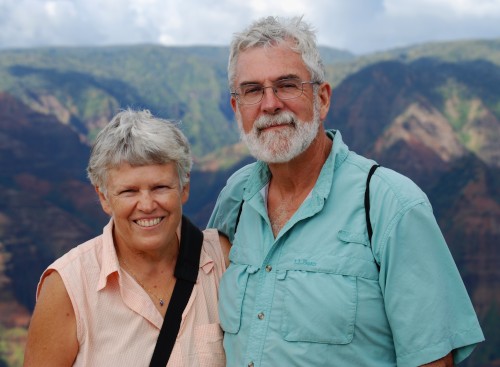
Who: Craig & Barbara Johnston
Port: Portland, Or
